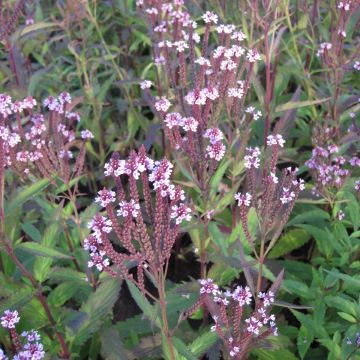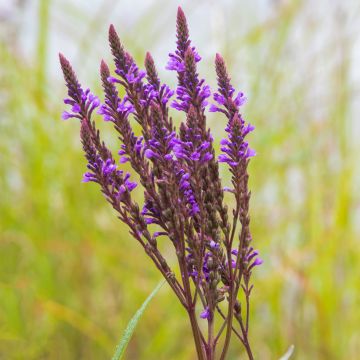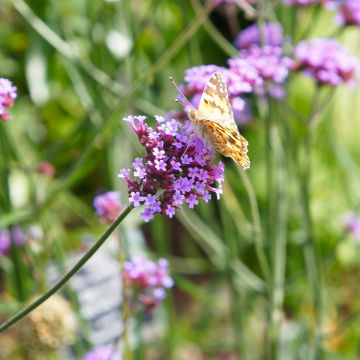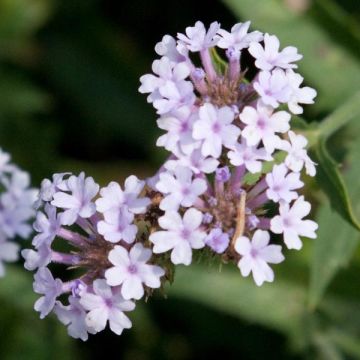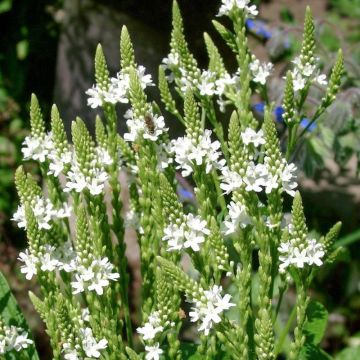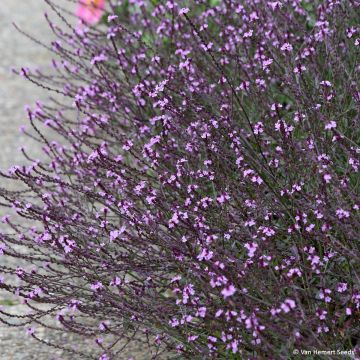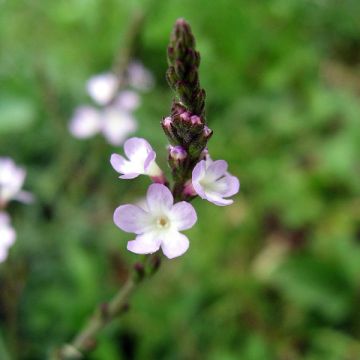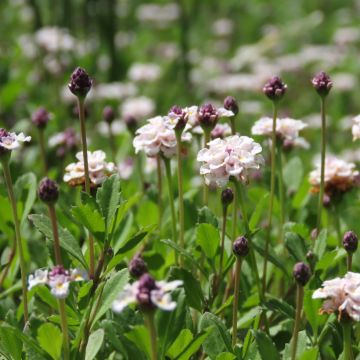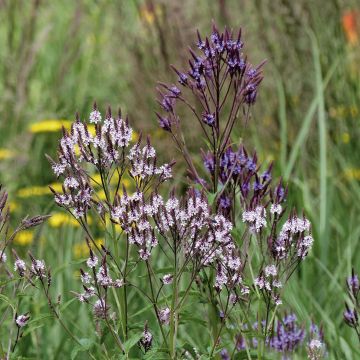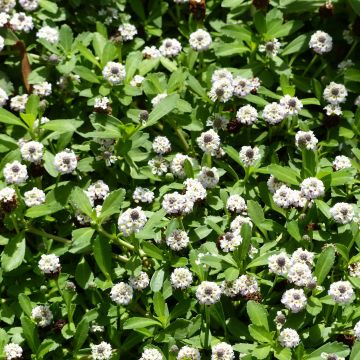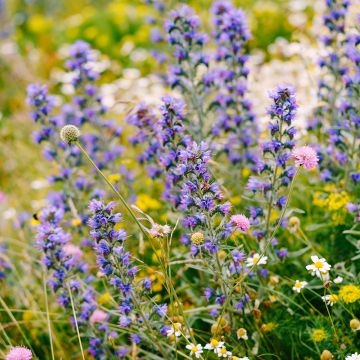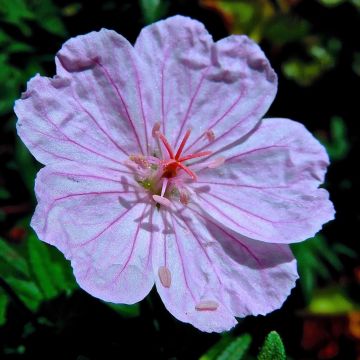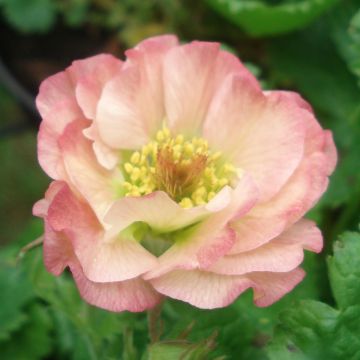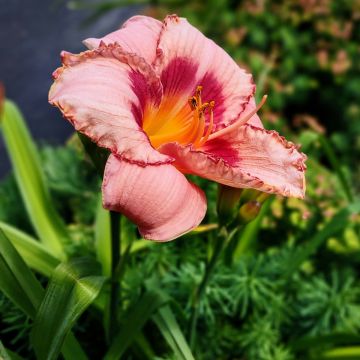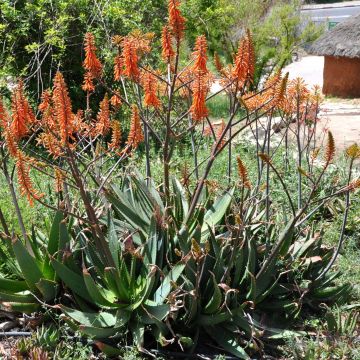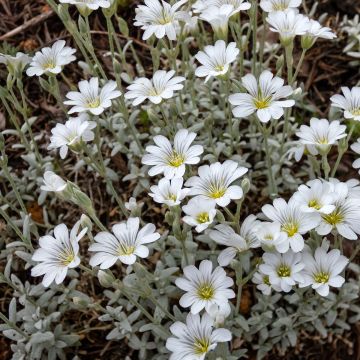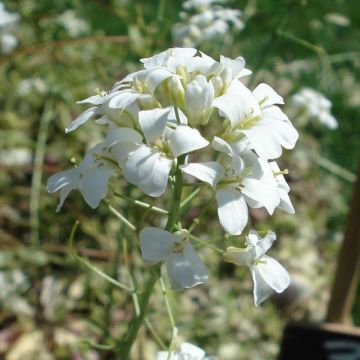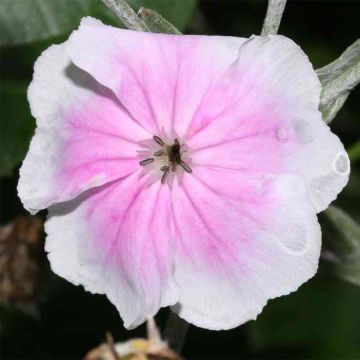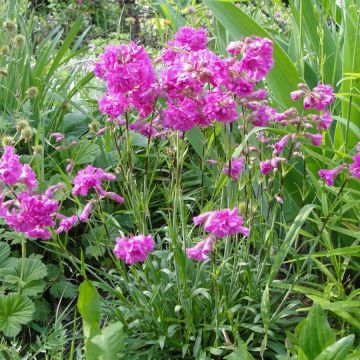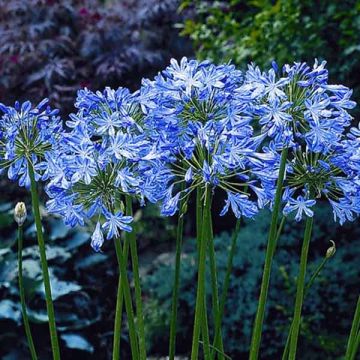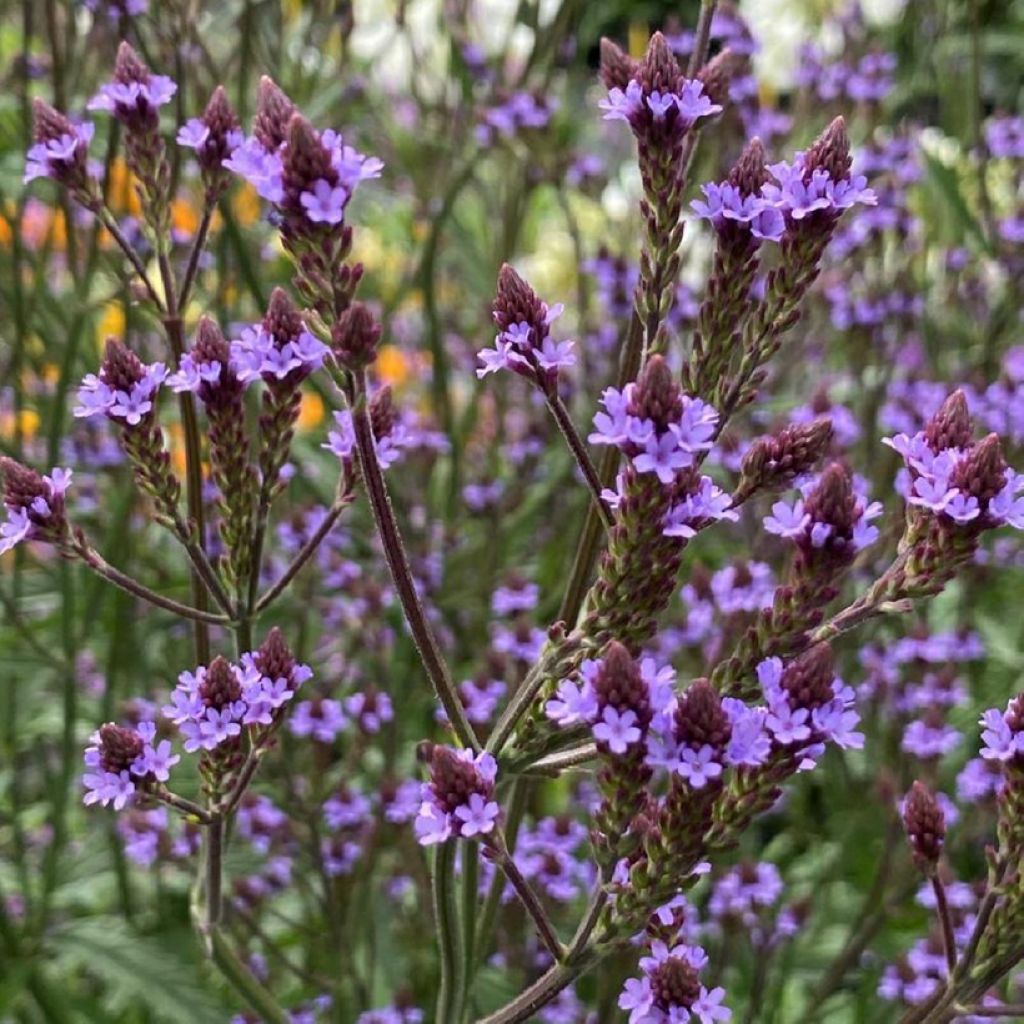

Verbena macdougalii Lavender Spires
Verbena macdougalii Lavender Spires
Verbena macdougalii x hastata Lavender Spires
Macdougal's Vervain, Hastate Vervain
This item cannot be shipped to the selected country
Delivery charge from €5.90
More information
Schedule delivery date,
and select date in basket
This plant carries a 12 months recovery warranty
More information
We guarantee the quality of our plants for a full growing cycle, and will replace at our expense any plant that fails to recover under normal climatic and planting conditions.
From €5.90 for pickup delivery and €6.90 for home delivery
Express home delivery from €8.90.
Does this plant fit my garden?
Set up your Plantfit profile →
Description
Verbena macdougalii 'Lavender Spires' is a hybrid between MacDougal's verbena and the hastate verbena that combines the qualities of its two parents. it is as hardy as the second and tolerates dry soils like the first. And since it does not produce seeds, it blooms generously throughout the summer. It forms a tall, dense, upright bush topped with complex candelabra, lavender-mauve inflorescences. Pollinating insects, especially butterflies, flock to it all day. Its many qualities make it welcome in our gardens.
Verbena macdougalii Lavender Spires belongs to the verbenaceae family. It is a horticultural creation resulting from cross-breeding Verbena hastata, a large species from wet soils native to Canada and the United States, and Verbena macdougalii, present in Arizona, New Mexico, western Texas, and Mexico. The Lavender Spires variety eventually forms a clump reaching 1.50m (5ft) high and 80cm (32in) wide. The vegetation consists of quadrangular stems which are sometimes branched towards their tips. The leaves are opposite, lanceolate, veined, coarsely toothed and vibrant green. From June to September, the stems branch out at their upper ends and produce spike-shaped inflorescences adorned with numerous purple buds that become small lavender mauve flowers, each measuring 5mm (0,2in) in diameter. The floral spikes bloom for several weeks, opening from bottom to top. The buds, flowers, and bracts form a splendid harmony of colours. The deciduous vegetation dries up in winter.
This Lavender Spires verbena is easy to grow and ornamental, making it an excellent perennial for the summer garden. It is valuable for providing height to perennial beds and delightful in country-style flower arrangements. This plant looks remarkable with gauras, grasses (miscanthus, eragrostis, panicum), or alongside royal catchfly (Silene regia), another beauty of North American meadows. Its architectural floral spikes highlight the roundness of roses, and complement Russian sage. They look wonderful with the grey or silver foliage of shrubby wormwoods, metallic blue tufts of Elymus magellanicus, and pink plumes of Muhlenbergia capillaris. It also looks beautiful with tall thistles, pink or mauve shrubby salvias, and a Crambe cordifolia...
Report an error about the product description
Verbena macdougalii Lavender Spires in pictures
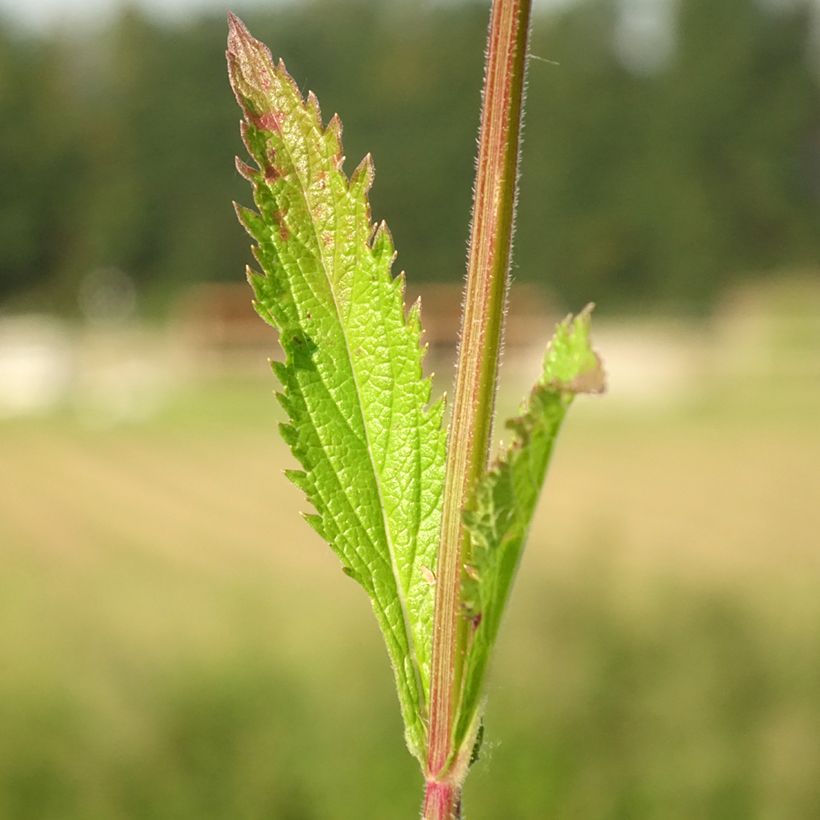

Flowering
Foliage
Plant habit
Botanical data
Verbena
macdougalii x hastata
Lavender Spires
Verbenaceae
Macdougal's Vervain, Hastate Vervain
Cultivar or hybrid
Other Verbena - Vervain
Planting and care
You can plant Verbena Lavender Spires in any ordinary, well-prepared, loose, occasionally flooded or dry, neutral, acidic or alkaline soil, preferably in the sun or light shade in very hot regions. However, it prefers loamy and fertile soils. Water well to help your plant establish itself, then in the first summer if it is very dry. This verbena will be happy with rainwater after that, except in the driest regions where a few generous but spaced waterings will be appreciated in summer.
Planting period
Intended location
Care
-
, onOrder confirmed
Reply from on Promesse de fleurs
Summer flowering perennials
Haven't found what you were looking for?
Hardiness is the lowest winter temperature a plant can endure without suffering serious damage or even dying. However, hardiness is affected by location (a sheltered area, such as a patio), protection (winter cover) and soil type (hardiness is improved by well-drained soil).

Photo Sharing Terms & Conditions
In order to encourage gardeners to interact and share their experiences, Promesse de fleurs offers various media enabling content to be uploaded onto its Site - in particular via the ‘Photo sharing’ module.
The User agrees to refrain from:
- Posting any content that is illegal, prejudicial, insulting, racist, inciteful to hatred, revisionist, contrary to public decency, that infringes on privacy or on the privacy rights of third parties, in particular the publicity rights of persons and goods, intellectual property rights, or the right to privacy.
- Submitting content on behalf of a third party;
- Impersonate the identity of a third party and/or publish any personal information about a third party;
In general, the User undertakes to refrain from any unethical behaviour.
All Content (in particular text, comments, files, images, photos, videos, creative works, etc.), which may be subject to property or intellectual property rights, image or other private rights, shall remain the property of the User, subject to the limited rights granted by the terms of the licence granted by Promesse de fleurs as stated below. Users are at liberty to publish or not to publish such Content on the Site, notably via the ‘Photo Sharing’ facility, and accept that this Content shall be made public and freely accessible, notably on the Internet.
Users further acknowledge, undertake to have ,and guarantee that they hold all necessary rights and permissions to publish such material on the Site, in particular with regard to the legislation in force pertaining to any privacy, property, intellectual property, image, or contractual rights, or rights of any other nature. By publishing such Content on the Site, Users acknowledge accepting full liability as publishers of the Content within the meaning of the law, and grant Promesse de fleurs, free of charge, an inclusive, worldwide licence for the said Content for the entire duration of its publication, including all reproduction, representation, up/downloading, displaying, performing, transmission, and storage rights.
Users also grant permission for their name to be linked to the Content and accept that this link may not always be made available.
By engaging in posting material, Users consent to their Content becoming automatically accessible on the Internet, in particular on other sites and/or blogs and/or web pages of the Promesse de fleurs site, including in particular social pages and the Promesse de fleurs catalogue.
Users may secure the removal of entrusted content free of charge by issuing a simple request via our contact form.
The flowering period indicated on our website applies to countries and regions located in USDA zone 8 (France, the United Kingdom, Ireland, the Netherlands, etc.)
It will vary according to where you live:
- In zones 9 to 10 (Italy, Spain, Greece, etc.), flowering will occur about 2 to 4 weeks earlier.
- In zones 6 to 7 (Germany, Poland, Slovenia, and lower mountainous regions), flowering will be delayed by 2 to 3 weeks.
- In zone 5 (Central Europe, Scandinavia), blooming will be delayed by 3 to 5 weeks.
In temperate climates, pruning of spring-flowering shrubs (forsythia, spireas, etc.) should be done just after flowering.
Pruning of summer-flowering shrubs (Indian Lilac, Perovskia, etc.) can be done in winter or spring.
In cold regions as well as with frost-sensitive plants, avoid pruning too early when severe frosts may still occur.
The planting period indicated on our website applies to countries and regions located in USDA zone 8 (France, United Kingdom, Ireland, Netherlands).
It will vary according to where you live:
- In Mediterranean zones (Marseille, Madrid, Milan, etc.), autumn and winter are the best planting periods.
- In continental zones (Strasbourg, Munich, Vienna, etc.), delay planting by 2 to 3 weeks in spring and bring it forward by 2 to 4 weeks in autumn.
- In mountainous regions (the Alps, Pyrenees, Carpathians, etc.), it is best to plant in late spring (May-June) or late summer (August-September).
The harvesting period indicated on our website applies to countries and regions in USDA zone 8 (France, England, Ireland, the Netherlands).
In colder areas (Scandinavia, Poland, Austria...) fruit and vegetable harvests are likely to be delayed by 3-4 weeks.
In warmer areas (Italy, Spain, Greece, etc.), harvesting will probably take place earlier, depending on weather conditions.
The sowing periods indicated on our website apply to countries and regions within USDA Zone 8 (France, UK, Ireland, Netherlands).
In colder areas (Scandinavia, Poland, Austria...), delay any outdoor sowing by 3-4 weeks, or sow under glass.
In warmer climes (Italy, Spain, Greece, etc.), bring outdoor sowing forward by a few weeks.

































